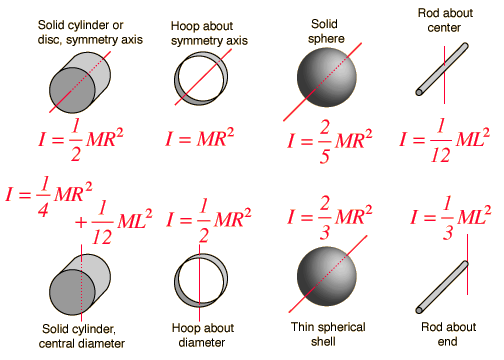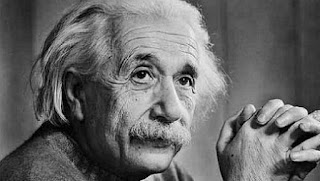Moment of Inertia
 |
Moment of Inertia (Mass Moment of Inertia) - I - is a measure of an object's resistance to changes in the rotation direction. Moment of Inertia has the same relationship to angular acceleration as mass has to linear acceleration.
- Moment of Inertia of a body depends on the distribution of mass in the body with respect to the axis of rotation
For a point mass the Moment of Inertia is the mass times the square of perpendicular distance to the rotation reference axis and can be expressed as
I = m r2 (1)whereI = moment of inertia (kg m2, slug ft2)m = mass (kg, slugs)r = distance between axis and rotation mass (m, ft)
Example - Moment of Inertia of a Single Mass
 |
| Add caption |
The Moment of Inertia with respect of rotation around the z-axis of a single mass of 1 kg distributed as a thin ring as indicated in the figure above, can be calculated as
Iz = (1 kg) ((1000 mm)(0.001 m/mm))2
= 1 kg m2
Moment of Inertia - Distributed Masses
Point mass is the basis for all other moments of inertia since any object can be "built up" from a collection of point masses.
I = ∑i mi ri2 = m1 r12 + m2 r22 + ..... + mnrn2 (2)
For rigid bodies with continuous distribution of adjacent particles the formula is better expressed as an integral
I = ∫ r2 dm (2b)wheredm = mass of an infinitesimally small part of the body
Moment of Inertia - General Formula
A generic expression of the inertia equation is
I = k m r2 (2c)wherek = inertial constant - depending on the shape of the body
Radius of Gyration
The Radius of Gyration is the distance from the rotation axis where a concentrated point mass equals the Moment of Inertia of the actual body. The Radius of Gyration for a body can be expressed as
rg = (I / m)1/2 (2d)
where
rg = Radius of Gyration (m, ft)
I = Moment of inertia for the body (kg m2, slug ft2)
m = mass of the body (kg, slugs)
Some Typical Bodies and their Moments of Inertia
Cylinder
Thin-walled hollow cylinder
Moments of Inertia for a thin-walled hollow cylinder is comparable with the point mass (1) and can be expressed as:
I = m r2 (3a)wherem = mass of the hollow (kg, slugs)r = distance between axis and the thin walled hollow (m, ft)ro = distance between axis and outside hollow (m, ft)
Hollow cylinder
I = 1/2 m ( ri2 + ro2) (3b)wherem = mass of hollow (kg, slugs)ri = distance between axis and inside hollow (m, ft)ro = distance between axis and outside hollow (m, ft)
Solid cylinder
I = 1/2 m r2 (3c)wherem = mass of cylinder (kg, slugs)r = distance between axis and outside cylinder (m, ft)
Circular Disk
I = 1/2 m r2 (3d)wherem = mass of disk (kg, slugs)r = distance between axis and outside disk (m, ft)
Sphere
Thin-walled hollow sphere
I = 2/3 m r2 (4a)wherem = mass of sphere hollow (kg, slugs)r = distance between axis and hollow (m, ft)
Solid sphere
I = 2/5 m r2 (4b)wherem = mass of sphere (kg, slugs)r = radius in sphere (m, ft)
Rectangular Plane
Moments of Inertia for a rectangular plane with axis through center can be expressed as
I = 1/12 m (a2 + b2) (5)wherea, b = short and long sides
Moments of Inertia for a rectangular plane with axis along edge can be expressed as
I = 1/3 m a2 (5b)
Slender Rod
Moments of Inertia for a slender rod with axis through center can be expressed as
I = 1/12 m L2 (6)whereL = length of rod
Moments of Inertia for a slender rod with axis through end can be expressed as
I = 1/3 m L2 (6b)

Comments
Post a Comment